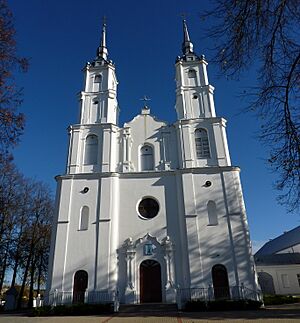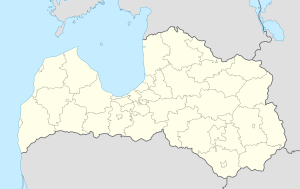Viļāni facts for kids
Quick facts for kids
Viļāni
|
|||
|---|---|---|---|
|
Town
|
|||

The Roman Catholic Church of Archangel Michael
|
|||
|
|||
| Country | |||
| Municipality | Rēzekne Municipality | ||
| Town rights | 1928 | ||
| Area | |||
| • Total | Lua error in Module:Wd at line 1,575: attempt to index field 'wikibase' (a nil value). km2 (Formatting error: invalid input when rounding sq mi) | ||
| • Land | Lua error in Module:Wd at line 1,575: attempt to index field 'wikibase' (a nil value). km2 (Formatting error: invalid input when rounding sq mi) | ||
| • Water | Expression error: Unexpected < operator. km2 (Formatting error: invalid input when rounding sq mi) | ||
| Population
(2024)
|
|||
| • Total | 2,749 | ||
| Time zone | UTC+2 (EET) | ||
| • Summer (DST) | UTC+3 (EEST) | ||
| Postal code |
LV-4650
|
||
| Calling code | +371 646 | ||
| Website | http://www.vilani.lv | ||
Viļāni is a town located in the Latgale region of Latvia. It is part of Rēzekne Municipality. The town is an important crossing point for transport, with the railway line and main highway connecting Riga and Moscow passing through it. The Malta River also flows through Viļāni. In 2020, about 2,813 people lived here.
Contents
History of Viļāni: A Journey Through Time
Viļāni was first mentioned in history in 1495. Back then, it was known as Wielona.
Early Development and Important Owners
In 1507, the largest estate in the Latgale region became the property of the de Overlak family. Later, in 1752, a person named M. Riks bought the Viļāni estate. He was a very important landlord (a person who owned a lot of land) who helped the area grow a lot.
Under his leadership, a monastery (a place where monks live) and the St. Michael church were built. These buildings were made in the beautiful baroque style. Monks from the Bernardine Order lived in the monastery. It even had a library with many old church books.
Growth as a Trade Center
Viļāni grew quickly because it was located on a major trade route between Riga and Rēzekne. In 1839, the Viļāni estate was bought by Vincent Janovskis.
Factories and Businesses in the 1800s
In the early 1850s, Janovskis built a large, three-story flax mill. At that time, there were only three such mills in the entire Russian Empire. Viļāni also had Russia's biggest leather factory! This factory made items like belts, bags, footwear, and saddles for the army.
The estate also had other small factories, including two limekilns (for making lime), a brick factory, and breweries. By 1852, Viļāni was called a hamlet, which is a small village. It had 12 houses, a two-story White tavern (an old inn), and several shops and bakeries. In 1862, Viļāni officially became a hamlet.
Becoming a Town and Modern Times
In 1924, some monks and priests came to Viļāni. They helped to fix up the abbey (a type of monastery) and added a second floor to the building. By 1925, Viļāni had four schools.
Viļāni officially became a town on February 25, 1928. It covered an area of 1.63 square kilometers and had 65 businesses. During World War II, the town was affected by the war and suffered damage. About half of its inhabitants were impacted. Viļāni was later recaptured on July 28, 1944.
Population of Viļāni
According to data from the Centrālās statistikas pārvalde (Central Statistical Bureau) at the beginning of 2019, there were 2,850 people living in Viļāni.
Exploring Viļāni: Notable Places and Buildings
Viļāni has several interesting buildings and places to visit.
Architectural Wonders
The Viļāni Catholic church and its monastery building, both built in the 1700s, are important historical buildings. The old manor house of the Viļāni estate, along with its park, is also a remarkable sight. The monastery buildings, with their special inner yard, are a great example of how Bernardian Order monasteries were designed in Latvia.
The Viļāni railway station is another interesting architectural monument. The inside of this building still looks much like it did when it was built, showing a mix of different styles.
Recreation and Museums
The Lakstīgalu sala, which means 'island of nightingales', is a favorite spot for locals to relax. It has an open-air stage and is located near the Viļāni estate.
If you want to learn more about the town, you can visit the Viļāni museum. It tells the story of Viļāni from ancient times to today. There's also the Viļāni forest museum, which displays about 100 different animals that live in the forests of the Latgale region.
Memorials and Tributes
Several memorial plaques and crosses honor important events and people in Viļāni's history:
- A memorial plaque for the victims of the totalitarian regime was put up in 1995.
- Another plaque honors the liberators of Viļāni from January 11, 1920.
- A memorial cross for national fighters against the Soviet regime was placed in 1999.
Economy: How Viļāni Works
Viļāni is home to 58 businesses, including 8 branch offices.
Key Industries and Services
Some of the largest businesses include a woodworking company, a charcoal producing company, and the “Katoļu dzeive” printing house. The town also has its own local television station, which started in 1992.
The Viļāni hydroelectric power station is also important. It was built in 1950 and updated in 1994. It was the first renewed private hydroelectric power station in Latvia.
See also
 In Spanish: Viļāni para niños
In Spanish: Viļāni para niños




